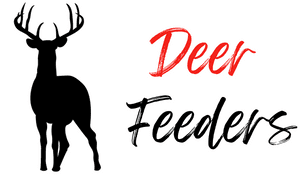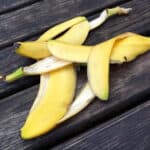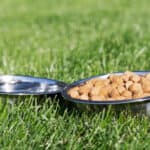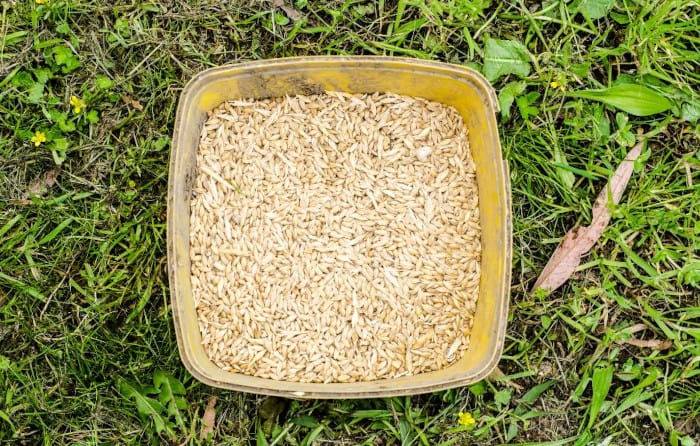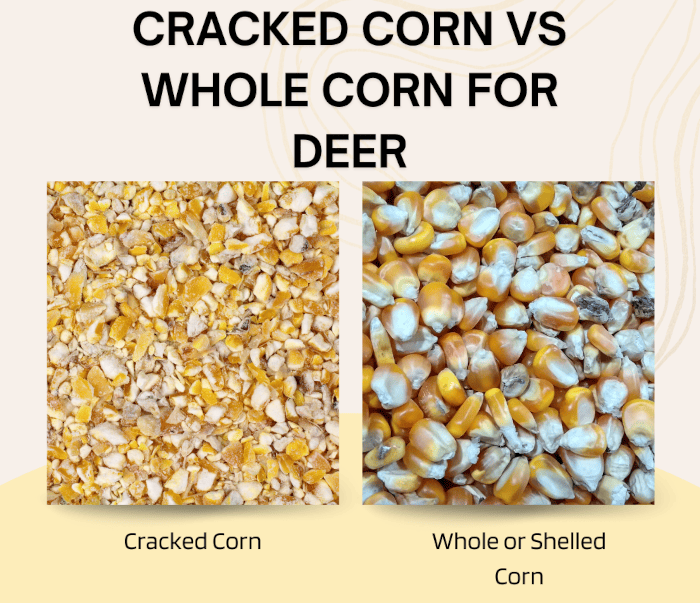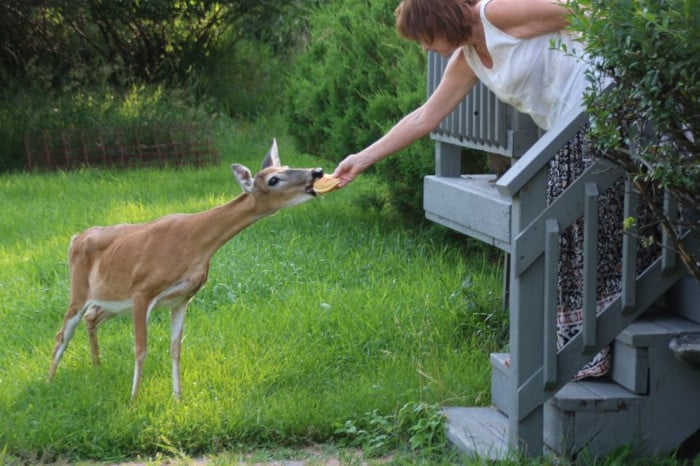As a deer hunter with over three decades of experience hunting whitetail deer, I can say with certainty that one of the weirdest questions I’ve been asked about these majestic creatures is whether or not they eat meat. It’s a question that has long puzzled people, and for good reason – deer are known to be herbivores, feeding on various plants and grasses. However, there have been reports of deer scavenging on animal carcasses and even actively hunting small prey. So, the question remains: do deer eat meat?

In this article, I’ll be delving into the world of deer biology and behavior in an effort to provide you with a comprehensive answer to this question. I’ll explore the evidence for and against deer eating meat, discuss the factors influencing their dietary choices, and look at the potential implications for deer and their ecosystems. Hopefully, by the end of this post, you’ll be able to make an informed decision about whether or not deer are herbivores or omnivores.
I was in my late 20s when I first started hearing reports of hunters claiming to have witnessed a whitetail deer eating some kind of meat. To be clear, I tend to be a bit cynical when it comes to believing some things and prefer hard data (like video or photographs) over unsubstantiated claims. So, when I first heard about hunters who had personally witnessed a deer being carnivorous or feeding on a carcass, I found it very hard to believe without some kind of proof.
While herbivorous animals such as cows or horses rely solely on vegetation for sustenance, there’s plenty of evidence that deer will occasionally supplement their diet with small amounts of carnivorous fare like small mammals or carrion.
Deer Are Suppose to Be Herbivores, Aren’t They?
Officially speaking, whitetail deer is a species of herbivore mammal known to consume large amounts of plant material. They possess a four-chambered stomach, which enables them to efficiently digest the cellulose found in plants and process their food into energy more effectively than many other mammals.
As ruminants, they can extract nutrients from their diet by regurgitating partially digested food for further breakdown by bacteria and enzymes in the first stomach.
Deer generally feeds on grasses, legumes, shoots, leaves, cacti (in deserts), prairie forbs, acorns, fruit, corn, and hay, but can also be found consuming mushrooms and even poison ivy due to their multi-chambered stomachs. The items they feed on vary seasonally according to the availability of these sources.
Can Deer Eat Meat?
White-tailed deer, primarily herbivorous animals, have been known to consume meat when the need arises occasionally. Such instances of carnivory typically involve small mammals and birds that cannot escape. There have also been reports of deer eating a dead rabbit. However, these occurrences tend to be rare as most deer rely on plant matter for sustenance.
When an additional source of minerals is required, whitetails may resort to osteophagy, which is the practice of consuming bones from dead animals.

The Hard Proof that Deer are Occasional Carnivores
Like I said before, it’s hard to argue with the evidence, so here’s some data:
Documented Cases of Whitetail Deer Predation on Nestling songbirds
As part of a research study from 1996 to 1999, researchers from the Northern Prairie Wildlife Research Center placed video recording devices on the ground nests of several songbirds to gather data on the predation rates and primary species of predators.
When the data was compiled, researchers noted several of the expected species, like foxes, weasels, and squirrels, visiting the nests and taking eggs. However, the research staff was surprised to see that whitetail deer had the most visits to the nests. Even more alarming: the deer were caught on camera removing baby birds from the nests and consuming them. And these incidences of predatory behavior by deer included several instances, so this behavior wasn’t restricted to a single incident and appeared to involve several different deer.
In another report, a research program posted in the Southern Naturalist reported and displayed video and photographic evidence showing whitetail deer locating and consuming Bobwhite eggs from different nests.

Image Source Credit: Youtube Mark Rumble
Deer Consuming Birds Caught in Mist Nets
When biologists or researchers need to catch birds for banding, tagging, or study, they typically use a fine mesh net between known bird flight areas. These nets are commonly called “mist nets.”
There are several reports (some even dating back to the late 1960s) of whitetail deer feeding on birds that were caught in mist nets. Source: https://sora.unm.edu/sites/default/files/journals/jfo/v049n02/p0184-p0184.pdf
I also found several references to a Canadian-based research study where mist nets were used to catch birds for banding. However, members of the research group observed a small group of whitetail deer locate and consume several birds trapped in the netting. Although I found several mentions of this study, I could not find specific details, publications, or links to the study.
Confirmed Case of Osteophagy Involving a Human Skeleton
In 2014, forensic scientists and researchers from the Forensic Anthropology Research Facility in San Marcos, Texas, recorded an image of a whitetail deer chewing on a bone from a human rib cage. This facility studies the effects of decomposition on the human body and positioned a set of cameras over a donated body to gather information on the impact of scavengers on the decomposition process.
In reviewing the photos, the research team had images of a whitetail deer chewing on a rib bone from the decomposed body.

Image Credit: Forensic Anthropology Center at Texas State
In addition to this image, there are have been other reports of whitetails chewing on human bones or even scavenging human remains. However, these incidences don’t indicate that deer will consume human flesh in a traditional sense. It means that deer are occasional scavengers who will feed on deceased or dead animals, especially when natural food sources are hard to find.
Osteophagy has been observed in several animal species (including elk and squirrel) living in both temperate and tropical environments but remains largely uncommon among white-tailed deer populations.
Videos of Whitetail Deer Consuming Birds
The video below is a home video shot in 2011 that shows a young buck finding and consuming a baby bird.
In this video from 2022, a young buck consumes what appears to be a dead bird:
The data provided clearly shows that deer are opportunistic eaters who will consume meat when the opportunity arises.
My Experiences
With over thirty years of deer hunting under my belt, I can honestly say that I haven’t personally observed any incidents of direct predation by a whitetail deer.
However, I once observed a situation where two does (female deer) appeared to be feeding on the carcass of a decomposing cow when I was deer hunting at a ranch in South Texas. In that situation, I was sitting in a tower blind and thought I picked up the faint odor of decomposing or rotting flesh. As I tried to investigate with binoculars, I located several vultures around what appeared to be the carcass of a cow.
I made a mental note to keep checking on the carcass for a possible coyote in the event that I didn’t have any luck with a buck. About 30 minutes into my afternoon hunt, I saw several vultures fly up from the carcass as if something had scared them off. Then, as I looked through the binos, I spotted two does at the carcass.
At first, I thought they were just investigating out of curiosity or based on the smell. However, as I watched, I observed them pulling on the carcass as if trying to pull some meat off the bones. Then I saw them actually consuming what looked like carrion or possibly part of a hide. They stayed at the carcass, fed for a few minutes, and then moved on.
In addition to that situation, I’ve also observed squirrels in the wild chewing or gnawing on animal bones.
How Often Do Deer Consume Meat?
I suspect that deer are more omnivorous than previously thought, as they will consume both plants and meat. However, these instances of predation appear relatively rare compared to the amount of vegetation and plants they consume in their natural environment.
Based on my experience, I suspect that the consumption of meat by whitetail deer is pretty uncommon.
As mentioned before, I’ve been hunting deer for over 30 years and have spent hundreds or maybe even thousands of hours hunting deer. Yet, in all that time, I haven’t personally witnessed any deer predation to date.
What Drives Deer to Consume Meat?
Within the deer biology and deer wildlife community, there are several theories that have been discussed as an explanation for this predatory or scavenger behavior. Here are a few of the most prominent theories:
Natural Food Sources are Scarce, so the Deer Are Forced to Eat Meat
While that potential explanation makes perfect sense to me, I’m not sure that the video evidence backs it up. If you look at both of the videos I referenced above, both of the bucks have antlers in velvet, so the time of year is likely to be late summer. In addition, in each of the videos, you can clearly see that most of the foliage and ground cover is green. These factors indicate that those videos were shot during the middle to late summer, so there would have been a substantial amount of natural food sources available.
However, in situations where natural food sources become scarce, I can see where a deer population might have to venture outside of their normal diet for survival.
The Predation is Primarily Done by Bucks Who Need Additional Minerals for Antler Growth
Based on my experience, this explanation has some potential validity as well. However, there seem to be just as many confirmed incidences of predation for does. In fact, some evidence seems to indicate that does might actually consume meat more often than bucks.
Deer Are More Opportunistic Eaters That Resort to Predation When the Opportunity Arises
Of all the different theories or ideas that have been offered to explain why and how deer become meat eaters, this specific theory holds the most value for me. As I mentioned previously, while deer seem to predominately be herbivores, they will switch to a broader omnivore diet when the opportunity comes up.
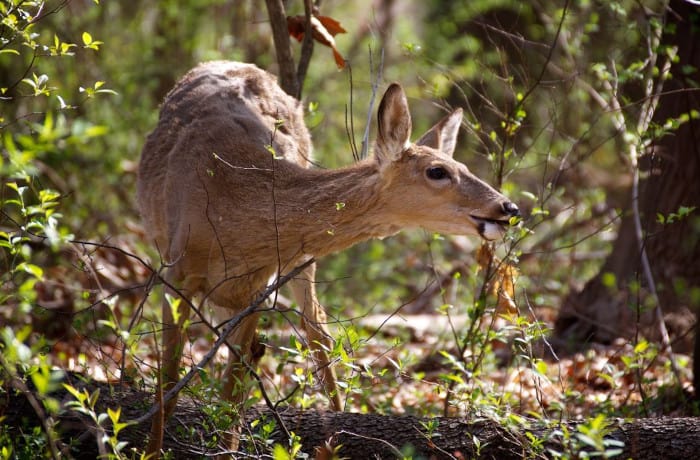
If Deer Are Herbivores, How Do They Digest Meat?
It may seem counterintuitive for an herbivore like the white-tailed deer to consume meat, but it obviously occurs. So how are these animals able to digest this type of food?
The answer lies in their complex physiology as ruminants, which allows them to utilize foregut fermentation. Through cud chewing and saliva production, deer can break down large particles into smaller ones and mix them with necessary microbes that help facilitate digestion. This process allows them to extract nutrients from foods they wouldn’t normally be able to eat if they weren’t ruminants.
Are Deer Predators Who Kill and Consume Other Animals?
Deer are often thought of as strict herbivores, but they are more like omnivores. In fact, most deer species are far more flexible eaters than one might expect. While it is true that deer generally consume the majority of their diet from plants and vegetation such as grasses, nuts, fruits, and buds, they have also been known to include meat in their diets.
Research into the dietary habits of deer has made it clear that these creatures possess both omnivorous and scavenger-based behaviors alongside their regular consumption of plant matter.
Are they predators? Going off the traditional definition of a predator, deer don’t quite fit the description. However, they obviously show some predatory behavior, especially in situations where they catch and kill another mammal or bird for consumption.
Final Thoughts
As you can see from the referenced data, deer are primarily herbivores and rarely consume meat. However, there are confirmed cases where deer have displayed some predatory behavior and consumed meat. While they may occasionally eat carrion or ingest small amounts of meat while grazing, it is not a significant part of their diet.
